Home is a great place to carve up your core—after all, a six-pack is usually made in the kitchen. A six-pack is a sign of overall well-being and completes physical fitness, a healthy lifestyle, and a nutrient-rich diet that begins at home.
Whatever your fitness level, it’s always better to do an abs workout that helps to sculpt the abs and build a stronger core. Even if you don’t have your regular gym equipment, you can still do these ab exercises at home.
There are plenty of Abs exercises that you can do at home to get the six-pack of your dreams.
I’ll share 18 effective abs exercises (based on science and experience) that you can do right in your living room.
Furthermore, I will provide you with tips on proper form and modifications for beginners and advanced.
Want To Build Six Pack ABS: Use Our Free Calculator To Know Your Fat Loss Calories Requirement

- How To Train Complete Abs At Home Without Equipment
- Upper Abs Workout At Home
- Lower Abs Workout At Home
- At-Home Oblique Workout
- 18 Best Abs Exercises At Home
- 1. Bicycle Crunch
- 2. Crunch
- 3. V-Up
- 4. Mountain Climber
- 5. Frog Crunch
- 6. Standing Oblique Twist
- 7. Russian Twist
- 8. Lying Straight Leg Raise
- 9. Reverse Crunch
- 10. Oblique Crunch
- 11. Plank
- 12. Side Plank
- 13. Side Plank with Hip Abduction
- 14. Side Jackknife
- 15. Lying Bent-Knee Oblique Twist
- 16. Cross-Body Mountain Climber
- 17. Bird Dog
- 18. Alternate Heel Touch
- At-Home Abs Workout Routines
- 1. Choose the Right Exercises
- 2. Create a Routine
- 3. Allocate Time
- 4. Start with Warm-Up
- 5. Progressive Overload
- 6. Cool Down
- Abs Workout Plan Without Equipment
- 1. Abs Workout Routines
- 2. Oblique (Side Abs) Workout Routine
- FAQ
- Hardest Ab Exercises At Home
- Are ab exercises enough to get a six-pack?
- Can I do ab exercises every day?
- How can I make ab exercises more challenging at home?
- What’s the best time to do the exercises: morning or evening?
- References:
- BEST AT-HOME ABS WORKOUT: MUST-DO AB EXERCISES
How To Train Complete Abs At Home Without Equipment
As long as gravity exists, your bodyweight can provide a vigorous home workout to help you lose fat, improve strength and endurance, build muscle mass, and achieve six-pack abs.
Training your complete abs at home requires a comprehensive approach that targets the different areas of your abdominal muscles from various angles.
You, a well-rounded and defined midsection, train different areas of your abs from every angle.
Do some exercises that concentrate on your upper and lower abs, and some that work the often neglected side abs—or obliques—along with your deeper core muscles.
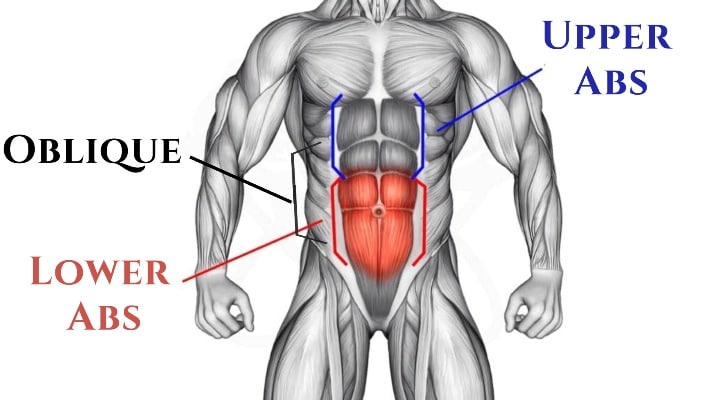
BODY FAT % CALCULATOR: KNOW YOUR BODY FAT PERCENTAGE TO GET VISIBLE ABS
Upper Abs Workout At Home
The main jobs of the rectus abdominal are flexion of the torso, which means forward bending (bringing your chest toward your hips), and flexion of the hips, which essentially means bringing your pelvic bone/hips upward.
Your upper abs will be the most activated during movements that bring your upper body toward your hips/legs (spinal flexion).
For example, the following exercises will target your upper abs:
- Crunches
- Sit-Up
- Vertical Leg Crunch
Lower Abs Workout At Home
When it comes to targeting the lower abs at home, it’s important to focus on exercises that bring your thighs toward your chest.
Through these specific movements, you will be able to isolate and strengthen the lower abs muscles effectively.
Here are some exercises that are known to work the lower abs.
- Leg raises,
- Reverse crunches and
- Mountain Climbers
At-Home Oblique Workout
The obliques work together to help you bend side to side, rotate your torso from left to right, and assist with spinal flexion.
For example, the following home exercises will target your oblique:
- Side Bend
- Twists
- Side Plank
Know More: Best Abs Exercises: Upper Abs, Lower Abs, Obliques
18 Best Abs Exercises At Home
Easy-to-follow core exercises for beginners, which don’t require any equipment.
1. Bicycle Crunch
In 2001, ACE sponsored a study to determine the best abs exercise. The study compared 13 of the most common moves, and the bicycle crunch was found to be the most effective.
Compared with the standard crunch, the bicycle crunch produced 148% more mean activity in the abs and 190% more mean activity in the obliques. Thus, the bicycle crunch is a great abs exercise to add to your home workout routines.
- To make the exercise beginner-friendly or easier, you can make the angle between your knees smaller
- To make it harder, you can make the angle between your legs bigger.

How To Do
- Lie on the floor with your legs straight and your lower back flat on the floor.
- Place your hands behind your head and raise your feet and upper back a little off the floor.
- Keep your neck neutral, and don’t pull your neck with your hands, or else you can get a neck strain.
- Slowly start raising your knees at about a 45-degree angle.
- Go through a bicycle peddling motion with your legs as you alternately touch your elbows to the opposite knees, twisting back and forth.
2. Crunch
Crunches are one of the all-time favorite ab exercises to do at home, but they have been linked to some risks if done improperly.
The crunch motion occurs in the upper spine, and your shoulders rise a few inches off the floor. Your lower back remains in contact with the floor, and the hips have no motion. In contrast, in sit-ups, the movement occurs at the waist and hips.
You may position your hands at your sides or across your chest, or you may interlock them behind your head.
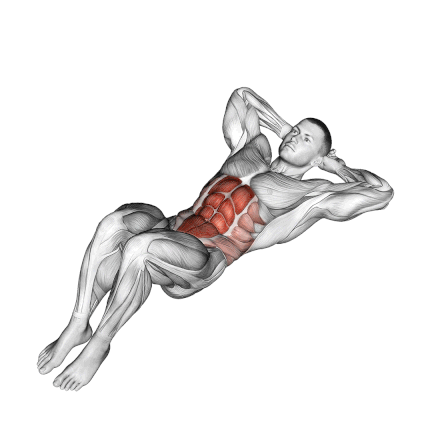
How To Do
- Lie down on the floor with your knees bent, your feet flat, and your lower back flat.
- Place your hands behind your head. Don’t pull on your neck with your hands; this will strain the neck.
- Lift your shoulders and upper back off the floor by contracting your ab muscles.
- Breathe out as you crunch, and maintain your core muscles tight and engaged.
- Hold this position briefly before slowly lowering back to the starting position.
3. V-Up
The V-Up, also known as a jackknife, is a great abs exercise to add to your home workout routine. It is a full-body move that works your core, legs, back, and shoulders.
The exercise works simultaneously with both the upper and lower abs muscles. You have to lift the weight of both your arms and legs by using your abdominal muscles to do the movement.
- For Beginner V-Up variations, Try: Partial V-Up, Alternating V-Up
- Advanced V-Up variations: Weighted V-Up
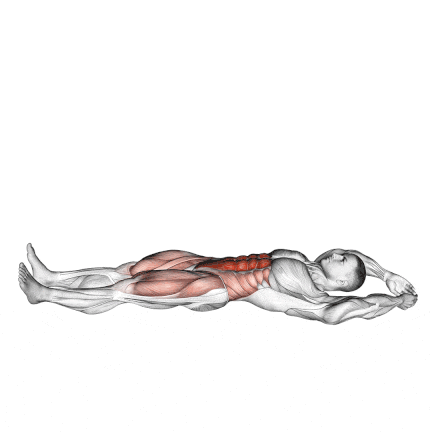
How To Do
- Lie on the floor on your back, arms straight back behind your head. Your legs should also be extended.
- Exhale and bend at your waist while raising your legs and arms to meet in a jackknife movement.
- Try to hold the contracted position. Squeeze the abs.
- Lower your arms and legs back to the starting position.
- Try to keep your back as straight as you can during the V sit-up.
4. Mountain Climber
Mountain climbing is an explosive bodyweight exercise that engages multiple muscle groups at once, helping to improve balance, coordination, strength, and flexibility. It is a great way to improve cardiovascular endurance and burn calories to get six-pack abs.
As you perform the move, your shoulders, arms, and chest work to stabilize your upper body while your core stabilizes the rest of your body. It’s particularly effective for strengthening your core muscles, including the abs, transverse abdominis, and obliques.
Mountain climbers are a great choice for home workouts because they can be done anywhere without any equipment.
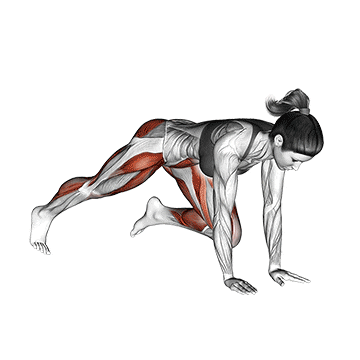
How To Do
- Start in the push-up position with your arms completely straight and directly beneath your shoulders.
- Don’t lift your hips too high. Your body should form a straight line from your shoulders to your ankles.
- Squeeze your abs, lift one foot off the floor and bring your knee up towards your chest while keeping your body in as straight of a line as possible.
- Return to the starting position and repeat the movement with your opposite leg.
5. Frog Crunch
Frog Crunch is an abdominal exercise that strengthens the rectus abdominus and helps flatten your abs.
Like other crunch variations, this leg position hits the muscle from a different angle, shocking the ab muscle and giving it a better shape.
When you keep your legs relaxed in the frog position, you reduce the extent to which your hip-flexing muscles. This helps you to isolate your abs and obliques.
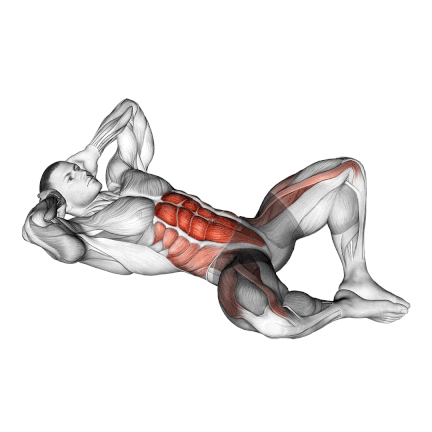
How To Do
- Lying on your back, bring the soles of your feet together.
- Place hands either lightly behind your head, touching your temple, or crossed over your chest.
- Using the muscles of your upper abs, raise your shoulders and upper back off the floor.
- Hold this position for a count of two.
- Then, lower your shoulders to the starting position, lightly touching the floor. Repeat.
6. Standing Oblique Twist
The Standing oblique twist is one of the best exercises to target your core muscles. It is one of the few exercises that specifically target the side muscles of your abs also known as “obliques”.
When you work out your oblique muscles, they become more visible, making your Love handles look slimmer and more defined.
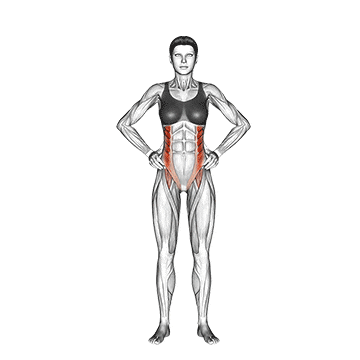
How To Do
- Grab a light barbell and rest it on your upper back, or bodyweight alone.
- Stand up straight, with your feet firmly on the floor in a stance wider than shoulder width.
- Slowly twist your torso to the right and then to the left. Tense up your midsection. Twist as far as possible.
- Try to keep your abs tight throughout the whole set.
- Keep the movement slow and under full control. Do not let momentum build because this can hurt your spine.
- Avoid using heavy weights because the momentum may become too difficult to control.
7. Russian Twist
The Russian twist is a great way to engage your core and strengthen your abdominal muscles as well as your lower back.
This exercise helps to tone and tighten your abs and obliques and trim your waist. It also improves your balance, stability, and posture.
A more advanced way of performing the Russian twist is to raise your feet a little off the floor and a weighted Russian twist.
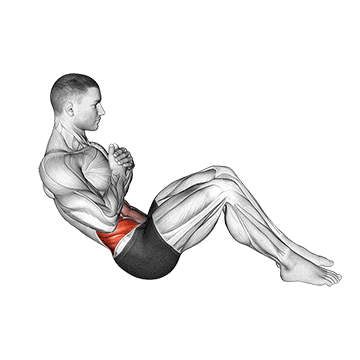
How To Do
- Lie down with your knee bent at the knees and feet flat on the ground.
- Elevate your upper body to create a V shape with your thighs.
- Begin to twist side to side while maintaining balance on your buttocks.
- Keep your back straight at all times and twist your torso only from the ribs up.
- Repeat this movement until the set is complete.
- Use a slow, controlled motion to target the muscles.
8. Lying Straight Leg Raise
If you are looking for an effective exercise for targeting the hip and lower abs, lying straight leg raises are a great option. They are safe and easy to do at home or the gym.
Lying leg raises can also help alleviate lower back pain by improving the strength and stabilization of the core.
It also strengthens the quadriceps muscles of the upper thigh without stressing the knee joint.
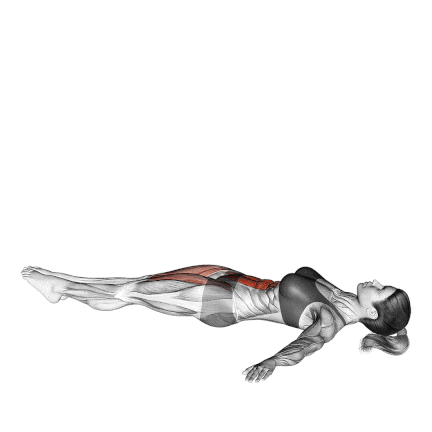
How To Do
- Lie face up on the floor/bench with your entire body straight and your hands at your sides to stabilize your torso.
- Hold your legs a few inches off the floor.
- Raise your legs up toward the ceiling until they are just short of perpendicular to the floor.
- Move slowly and with control, making sure not to arch your back.
- Slowly lower your legs back to the starting position.
9. Reverse Crunch
The reverse crunch is a challenging core exercise that primarily hits your lower abs. This is one of the most challenging ab exercises that you can incorporate into your home workout regimen.
The reverse crunch is an intermediate-level abs exercise. It is a variation of the crunch, but it is done in the opposite direction.
- In a crunch, you curl your upper body up towards your knees.
- In a reverse crunch, you curl your lower body up towards your chest.
To make this exercise more difficult, perform it on a decline bench with your head on the high end.
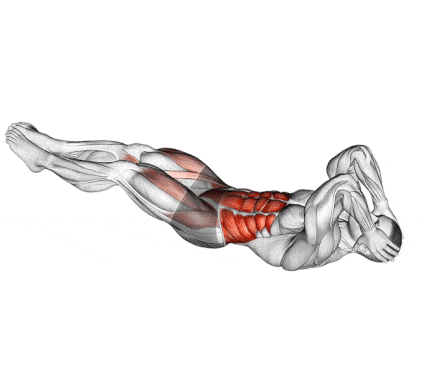
How To Do
- Lie on your back with your knees bent and your feet flat on the ground.
- Slowly bring your knees toward your chest, lifting your hips and glutes off the floor.
- Try to maintain the bend in your knees throughout the movement.
- Slowly lower your legs back to the starting position under control motion.
- Keep the movement slow and controlled. Do not use momentum.
10. Oblique Crunch
The oblique crunch is a bodyweight exercise that targets your core muscles—specifically the obliques on the sides of your abdomen.
It is a beginner-friendly core exercise that strengthens your abs and obliques, as well as the other core muscles, including your transverse abdominus and medial glute.
Hold a weight plate on your chest to make this exercise more difficult.

How To Do
- Lie on the floor on your right side with your hips and knees bent.
- Place your left hand behind your head and place your right hand across your body and on the obliques.
- Placing your hand on your obliques can help you feel the muscles contract and enhance the mind-muscle connection.
- Contract your obliques to lift your shoulder off the floor.
- Hold this position briefly, contracting your obliques as hard as possible. Then, return to the start position.
- Complete all reps on the left side and then repeat on the right side.
11. Plank
The plank, or planking, is an isometric core strength exercise that involves maintaining a position similar to a push-up.
The front plank is an exercise that works your core muscles and improves your strength, balance, and endurance. It is one of the best home workouts you can do.
Crunches and sit-ups only work the muscles on the front side of the core, so it’s necessary to do back strengthening exercises as well. However, planks work the entire core, as well as many other muscles in the body.

How To Do
- Start to get in a push-up position, bend your elbows, and rest your weight on your forearms.
- Your body should form a straight line from your shoulders to your ankles. Do not let your lower back sag or your butt rise.
- Your neck should be in line with your body, not tilted up, which could strain the neck.
- Brace your core by contracting your abs as if you were about to be punched in the gut.
- Hold this position for 20-60 sec.
Know More: Plank Exercise: Benefits, Variations, Muscles Worked, Tips
12. Side Plank
The side plank is one of the best abs exercises for strengthening the oblique muscles, which don’t get worked as much during abs exercises such as crunches. Strong obliques are quite useful as core stabilization muscles.
- If you’re new to planking, you should master the basic forearm plank before moving on to the side plank variation.
- If you find it hard to hold a side plank, that’s OK. You can try knee-side plank instead of forearm side plank.

How To Do
- Lie on your side with your legs extended and feet stacked on top of each other.
- Your elbow should be directly under your shoulder, your forearm flat on the ground, and your other hand resting on your hip.
- Raise your body by placing your right forearm flat on the floor so that it’s perpendicular to your torso.
- Tighten your core muscles, pulling your belly button towards your spine.
- Hold the position for as long as you can.
- Repeat on the other side
Know More: Side Plank: Benefits, Variations, Muscles Used, Tips
13. Side Plank with Hip Abduction
The side plank hip abduction is an advanced variation of the side plank that you can do to target the obliques and outer thighs.
The hip abductors move the legs away from the body and rotate them at the hip joint, so this plays an important role in keeping your knee and hip joints stable.
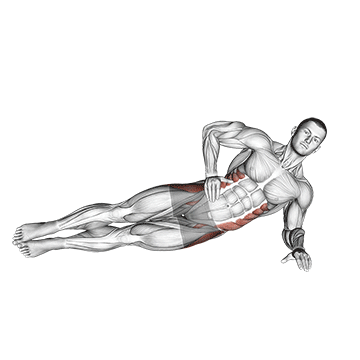
How To Do
- Lie on the floor, on your left side, side with your elbow directly beneath your shoulder and legs stacked.
- Place your free hand on your hip.
- Straighten your body and legs. Your feet should be together, and your hip should be resting on the floor.
- Brace your abs and lift your hips off the floor until you’re balancing on your forearm and feet and your body forms a diagonal line.
- Lift your right leg at least 6 inches. Slowly bring your feet back together and lower your hip to the floor.
- Repeat on your right side.
14. Side Jackknife
The side jackknife is a highly effective exercise that simultaneously trains both the obliques and abs. It is a moderate-level ab exercise that only requires the use of a mat.
Once you master the basic oblique V-up, you can increase the difficulty of the exercise by raising both legs off the ground.
The double side jackknife follows all the same steps as the side jackknife, except that you bring both your feet up while you raise your upper body.

How To Do
- Lie on your left hip, legs together and right leg on top of your left.
- Place your right hand behind your head, and your left elbow stays close to your body for support.
- Use your oblique muscles to raise your top leg while simultaneously raising your torso to meet it.
- Hold a total contraction at the top of the movement for a count of two.
- Lower in a controlled motion and repeat, until you complete your set.
- Don’t rest your leg and torso at the bottom until you complete the desired reps.
- Then, switch sides and repeat.
15. Lying Bent-Knee Oblique Twist
Lying Bent Knee twist is a beginner-friendly bodyweight exercise that builds muscle and strength in the obliques. This is a great moderate move and when done correctly, it can effectively target your core and abs.
You can do the weighted version of the exercise with a ball in between your legs.

How To Do
- Lie on your back on the floor or mat with arms extended out to the sides to keep your body stable during the exercise.
- Raise bent legs and bend your legs at a 90-degree angle, so your thighs are vertical and your lower legs are horizontal.
- Keep your core tight during the movement to activate your obliques against resistance.
- Keep your shoulders in contact with the floor and slowly lower your legs to one side until you feel a mild stretch in your lower back.
- Now, rotate your legs all the way to the right. Repeat for the desired number of reps.
16. Cross-Body Mountain Climber
This variation emphasizes the oblique muscles more than the standard mountain climber, enhancing the waistline. During this exercise, you must diagonally move your knees towards the opposite elbow.
The exercise works all the muscles in the body, including the abs, shoulders, chest, and legs. It’s a complete workout for everyone.
Cross-body mountain climbers increase your heart rate, making them a great addition to a high-intensity interval training (HIIT) routine.
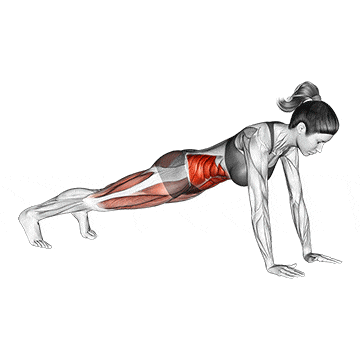
How To Do
- Start in the push-up position with your arms completely straight and directly beneath your shoulders.
- Your body should form a straight line from your shoulders to your ankles.
- Squeeze your abs, lift one foot off the floor, and bring your left knee towards your right elbow. Keep your body in as straight of a line as possible.
- Return to the starting position and repeat the movement with your opposite leg.
17. Bird Dog
A study has found that dead bug exercise was more efficient in improving core strength, endurance, and flexibility and may be used as an alternative to abdominal crunch exercise.
It is a bodyweight exercise that strengthens the core—more specifically, the abs, oblique muscles, lower back, glutes, and thighs.
The bird dog is a real stability exercise that ensures a stable trunk. It owes its name to the position, which alternates between sitting on hands and knees (dog) and stretching the arms and legs (bird).
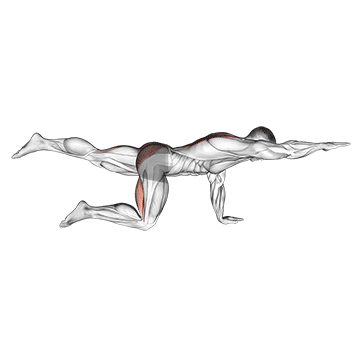
How To Do
- Get on your knees and place your hands on the floor in front of your body at shoulder width.
- Keep your spine in a neutral position and contract your abs and lift one hand and the opposite knee slightly off the floor.
- Now extend your arm and leg all the way out. Try to form a straight plane from your hand to your foot.
- Don’t raise your leg and arm higher than your back.
- Hold this position for about 10 seconds and then return to the starting position.
- Repeat the exercise with the other side. Repeat the exercise alternately.
18. Alternate Heel Touch
Alternate heel touches, also known as lying oblique reach, are an at-home workout exercise that targets the oblique and involves the abs.
It is one of the great side abs (oblique) exercises that beginners can easily do to activate and grow their midsection.
The exercise mimics other oblique exercises such as the dumbbell side bend and oblique crunch.

How To Do
- Lie down flat on the floor, your back, and hips touch the ground.
- Bend your knees and extend your hands along your torso.
- Now, contract your abs by pulling your belly button towards your spine.
- Now, crunch your torso to the right until you can touch your right heel with your right hand.
- Pause for a second and feel the stretching in your oblique muscles.
- Return to your starting position and then crunch to touch your left hand to the left heel.
- Don’t jerk from side to side; focus on oblique muscles while touching your foot.
At-Home Abs Workout Routines
Like any other muscle group, the abs need effective workout routines that train them with adequate volume and frequency, considered exercise selection, and progressive overload.
Here’s a step-by-step guide to incorporating ab workouts into your home routine:
1. Choose the Right Exercises
Select effective ab exercises in different core areas, including upper, lower, and oblique muscles. Some great choices include crunches, planks, leg raises, Russian twists, bicycle crunches, and mountain climbers.
2. Create a Routine
Decide how often you want to work on your abs. You can start with a few days per week, such as 2–3 days, and gradually increase if desired. Consistency is key.
You could train abs twice per week, one session using an abs exercise and the other using an oblique exercise, and achieve adequate volume throughout the whole area.
3. Allocate Time
Dedicate a specific time slot in your daily or weekly schedule for bodyweight workouts. This could be in the morning, during a break, or in the evening. Try to work out your abs for at least 15–20 minutes.
4. Start with Warm-Up
Begin each session with a brief warm-up to prepare your muscles. Do some light cardio, such as jogging in place or jumping jacks, followed by gentle dynamic stretches to loosen up your muscles.
5. Progressive Overload
As you become stronger, gradually increase the intensity of your home ab workouts. You can do this by adding more reps, holding positions longer, or doing advanced variations of the exercises.
6. Cool Down
After completing your ab exercises, finish with a gentle cool-down routine. Focus on stretching the muscles you worked and take a few minutes to relax.
Abs Workout Plan Without Equipment
Now, you can consider them when planning your workouts. You could use them as a finisher, picking two or three moves and cycling between them with minimal rest in between, or you could train your core separately.
Below are some sample workout plans to train your core, abs, and obliques separately without equipment.
1. Abs Workout Routines
| Exercises | Sets | Reps |
|---|---|---|
| Crunch | 3 | 10-15 |
| Russian Twist | 3-4 | 12-15 |
| Knee Raise | 3 | 8-12 |
| Plank | 3 | 8-12 |
2. Oblique (Side Abs) Workout Routine
| Exercises | Sets | Reps |
|---|---|---|
| Side Bend | 3 | 10-15 |
| Side Plank | 3-4 | 6-8 |
| Side Jackknife | 4 | 8-12 |
| Oblique Twists | 3 | 10-15 |
You don’t have to do only bodyweight exercises for your ab workouts.
In fact, you probably should mix it up with:
If you want a well-rounded abs and oblique and core workout, then you must add variation to your workout.
FAQ
Hardest Ab Exercises At Home
- V-ups
- Bicycle crunches with legs elevated
- Hollow Body Hold
- Scissors
- Windshield Wipers
- Dragon Flag
- Plank Toe Taps
- Weighted Russian twists
Are ab exercises enough to get a six-pack?
No abs exercises are not enough to get sex pack abs. Ab workouts are crucial for strengthening and toning the muscles. Achieving a visible six-pack also requires reducing body fat through a combination of a nutritious diet, cardio workouts, and muscle-building workouts.
Can I do ab exercises every day?
No, it’s not recommended to do ab exercises every day. The abdominal muscles need at least 2 full days of rest between workout sessions to recover and repair themselves.
Overtraining the abs without rest can lead to muscle fatigue, overuse injuries, and reduced results.
How can I make ab exercises more challenging at home?
To make ab exercises more challenging, you can increase the number of reps and add variations (e.g., side planks, cross-body mountain climbers).
Other ways to make the ab workout harder are to add weights, do more reps, hold an exercise position longer, do slow eccentric motions, do oblique rotations, and do exercises on an uneven surface.
What’s the best time to do the exercises: morning or evening?
The best time depends on your personal preference and schedule. Some people prefer morning workouts to kickstart their day, while others enjoy evening workouts to de-stress. Choose a time that fits your routine and helps you stay consistent.
Thanks for reading; enjoy your abs workout
Stay Fit, Life a Happy and Healthy Life
References:
- Chioma Ikele: Comparative Analysis of the Effects of Abdominal Crunch Exercise and Dead Bug Exercise on Core Stability of Young Adults. Nigerian Journal of Medicine 29 (December 2020).
- C Juan-Recio, A López-Vivancos, M Moya, J M Sarabia: Short-term effect of crunch exercise frequency on abdominal muscle endurance. J Sports Med Phys Fitness. 2015 Apr.
BEST AT-HOME ABS WORKOUT: MUST-DO AB EXERCISES

Manish is a NASM-certified fitness and nutrition coach with over 10 years of experience in weight lifting and fat loss fitness coaching. He specializes in gym-based training and has a lot of knowledge about exercise, lifting technique, biomechanics, and more.
Through “Fit Life Regime,” he generously shares the insights he’s gained over a decade in the field. His goal is to equip others with the knowledge to start their own fitness journey.
